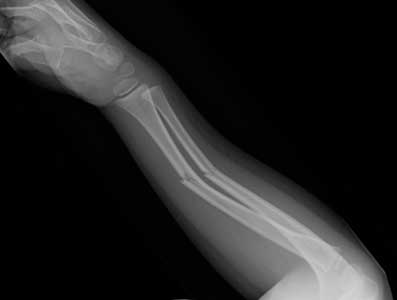A growth plate or also known as the epiphyseal plate is a thin layer of cartilage located between the shaft and the end of a bone. As the name suggests, it is responsible for the growth in height of children. To understand this, we have to know how a growth plate functions. Long bones such as the bones of the forearm and arm usually have a set of two growth plates for each bone, one at the top, and one at the bottom. Its particular function is to lengthen the bones longitudinally, and cumulatively leads to the growth of a child.
Growth plates can be found in babies, children and adolescents, not in adults. When they reach a certain age, normally around 16 for females and 19 in males, their growth plates harden, their cartilaginous substances become laden with bone minerals causing them to become bones and lose their ability to grow. Extrapolating from this understanding, it means that damage to the growth plates will affect the growth of the child.
Children can get their growth plate damaged through one or the other mechanisms. Either they could get it from a singular event such as a fall or trauma from an accident, or through repetitive stress on the child’s bones that overtime leads to fracture. Some factors may increase the likelihood of getting growth plate fracture. Among them are, gender; boys are more predisposed to get growth plate fractures because girls will stop growing earlier than boys. Next are those who engage in competitive sports like rugby, soccer, and also, recreational sports share the same risk, namely skateboarding, gymnastics and biking.
Damaged growth plates will heal differently and this depends on the type of fracture it had been subjected to. Most of the time it will heal without any lasting effect. Other times, it may have its complications. During its healing process, a bony bridge may form between the two ends of the broken bone, hindering its growth or may even cause the bone to curve. In correcting this deformity, your doctor will surgically remove the bony bridge, and they might consider putting in fat or other materials to prevent recurrence.

In addition to that, the growth plates after the damage may become more stimulated or suppressed, causing it to grow at a rate surpassing its opposite limb, or slow down the growth entirely, ultimately in either situation will lead to length discrepancy between the two limbs. Besides that, damage to the growth plates may also cause the limbs to assume a deformed orientation. The knee for example may bow inwards or outwards leading to conditions called genu valgus and genu varus respectively. All of these are correctable deformities by means of surgery.
Growth plate damage may happen in the event of fall and accident involving our children and as much as we want to keep them safe, misfortunes can happen to any of us. So while that may be inevitable, we have a choice to choose better outcomes for them. A fracture should be recognized early and should be brought to your doctor promptly for confirmation and treatment. Complementary medicine has a limited role in managing a fracture and growth plate damage. And after the growth plate damage has been addressed and attended to by your doctor, always follow your doctor’s advice to ensure your children do not develop complications.




